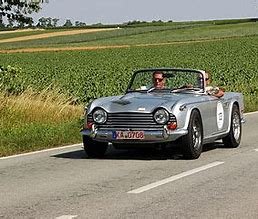The Triumph TR5 and TR250 are legendary British sports vehicles from the late 1960s. Despite their numerous commonalities, they nevertheless differ significantly in a few important ways. In this article, we will explore the history, specifications, and unique features of these two legendary vehicles.
A Brief History of the TR5 and TR250
The Triumph TR5 was introduced in 1967 as a replacement for the TR4A. It was powered by a 2.5-liter inline-six engine that produced 150 horsepower. The TR5 was a high-performance sports car that was capable of reaching a top speed of 120 mph. However, due to stricter emissions regulations in the United States, the TR5 was not sold in North America.
To comply with these regulations, Triumph introduced the TR250 for the North American market. The TR250 was essentially a detuned version of the TR5, with a 2.5-liter inline-six engine that produced 104 horsepower. While the TR250 was not as powerful as the TR5, it was still a respectable performer.
Both the TR5 and TR250 were produced for only two years, from 1967 to 1968. During this time, a total of 2,947 TR5s and 8,484 TR250s were produced.
Specifications and Features
The TR5 and TR250 shared many of the same specifications and features. Both cars were equipped with a four-speed manual transmission and independent front and rear suspension. They also featured a live rear axle and four-wheel disc brakes.
One of the key differences between the two cars was the engine. As mentioned earlier, the TR5 was equipped with a fuel-injected 2.5-liter inline-six engine that produced 150 horsepower. The TR250, on the other hand, was equipped with a carbureted 2.5-liter inline-six engine that produced 104 horsepower.
Another difference between the two cars was the styling. The TR5 featured a more aggressive front end with a distinctive grille and headlights. The TR250, on the other hand, had a more conventional front end with a more rounded grille and headlights.
Both the TR5 and TR250 were available with a variety of options, including a hardtop roof, wire wheels, and a Surrey Top. The Surrey Top was a removable soft top that could be easily installed or removed.
Performance and Handling
The TR5 was a high-performance sports car that was capable of accelerating from 0 to 60 mph in 8.8 seconds. The TR250, on the other hand, was a bit slower, with a 0-60 mph time of 10.6 seconds.
Both vehicles handled well and were enjoyable to drive. The TR5, with its more powerful engine, was a bit more exciting to drive. However, the TR250 was still a capable sports car that was enjoyable to drive.
Legacy
The TR5 and TR250 are now considered classic cars. Collectors and aficionados value them much. The TR5, in particular, is a rare and valuable car.
Both cars are still driven and enjoyed today. There are many clubs and organizations dedicated to preserving and restoring these classic cars.
The Birth of a Legend
The Triumph TR5 and TR250 are two iconic British sports cars that, despite their short production run, have left an enduring legacy. Born in the late 1960s, these cars were designed to offer thrilling performance and classic British style.
The TR5: A High-Performance Gem
The TR5 was a true performance machine. Its 2.5-liter inline-six engine, equipped with Lucas fuel injection, delivered a potent 150 horsepower. This allowed the car to accelerate from 0 to 60 mph in under 9 seconds and reach a top speed of over 120 mph.
However, due to stringent US emissions regulations, the TR5 was never officially sold in the North American market. This limited its production run and made it a rare and desirable classic car.
The TR250: A North American Compromise
To satisfy the American market, Triumph introduced the TR250. This model was essentially a detuned version of the TR5, featuring a carbureted 2.5-liter engine that produced 104 horsepower. While less powerful than its British counterpart, the TR250 still offered respectable performance and a thrilling driving experience.
Design and Styling
Both the TR5 and TR250 shared a similar design language, characterized by sleek lines, a long hood, and a short rear deck. The distinctive grille and headlights gave the cars a timeless appeal. The interior, while basic, was functional and driver-focused.
Frequently Asked Questions
What is the difference between a TR5 and a TR250?
The primary difference lies in their engines and intended markets. The TR5, with its fuel-injected 2.5-liter six-cylinder engine, was designed for European markets. The TR250, with a carbureted version of the same engine, was specifically built for the North American market to comply with stricter emissions regulations.
What are some common issues to look out for when buying a TR5 or TR250?
Common issues include rust, especially in the body and chassis. Electrical issues can also be problematic, particularly with the Lucas electrics.
How much does a TR5 or TR250 cost?
The value of a TR5 or TR250 can vary significantly depending on condition, mileage, and specific model. Generally, the TR5 is more valuable due to its rarity and performance. Prices can run anywhere from many thousands to several million of dollars.
How should a TR5 or TR250 be maintained?
Regular maintenance, such as oil changes, tune-ups, and inspections, is crucial. It’s also important to address rust issues promptly. Asking skilled owners or specialists that specialise in ancient automobiles for advice might be very beneficial.
Where can I find parts for a TR5 or TR250?
There are many specialist suppliers of parts for Triumph TR5 and TR250 models. Online forums and clubs can also be valuable resources for finding parts and advice.
Conclusion
The Triumph TR5 and TR250 are two iconic British sports cars that were produced in the late 1960s. Despite their numerous commonalities, they nevertheless differ significantly in a few important ways. They are still driven and enjoyed today, and there are many clubs and organizations dedicated to preserving and restoring these classic cars.
To read more, click here.

Leave a Reply